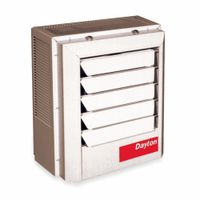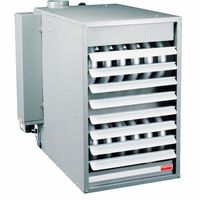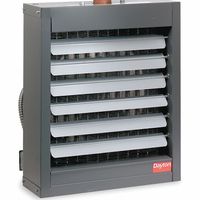Call +(254) 703 030 000 / 751 483 999 / 721 704 777
- Home
- Hvac And Refrigeration
- Heaters
.....Read More
Frequently Asked Questions
What is the most efficient type of heater for home use?
The most efficient type of heater for home use largely depends on specific needs, climate, and existing infrastructure. Generally, heat pumps are considered highly efficient, especially in moderate climates, as they transfer heat rather than generating it. Air source heat pumps can be very effective for both heating and cooling, while geothermal heat pumps offer even greater efficiency and stability due to consistent ground temperatures, though they have a higher upfront installation cost.
For homes without ductwork or those needing supplemental heating, ductless mini-split heat pumps are an excellent choice, providing zoned heating and cooling for individual rooms. In areas with colder climates, natural gas furnaces can be very efficient if gas prices are low and the furnace is a high-efficiency model (90% AFUE or higher). Electric baseboard heaters and portable electric heaters are generally less efficient for whole-home heating due to the direct conversion of electricity to heat, but can be useful for supplemental or localized heating in well-insulated spaces.
Ultimately, maximizing heating efficiency involves a combination of the right heating system for your home and climate, coupled with good insulation, proper sealing of drafts, and regular maintenance of the heating unit.
How do electric heaters compare to gas heaters in terms of cost and efficiency?
Electric heaters and gas heaters differ significantly in terms of both cost and efficiency.
**Cost:** * **Initial Cost:** Electric heaters typically have a lower initial purchase price compared to gas heaters, which often require professional installation, including gas lines and ventilation.
* **Operating Cost:** Gas heaters are generally more cost-effective to operate in many regions due to the lower price of natural gas compared to electricity. However, this can vary based on local utility rates and the specific models' efficiency. Propane gas heaters can be more expensive to run than natural gas due to higher fuel costs.**Efficiency:** * **Electric Heaters:** Electric heaters are considered 100% efficient at the point of use, meaning all the electricity consumed is converted into heat. However, the generation of electricity at power plants often involves significant energy losses, so the overall "well-to-wheel" efficiency can be lower.
* **Gas Heaters:** Gas heaters convert a significant portion of the fuel's energy into heat, but they lose some heat through the venting process. Modern high-efficiency gas furnaces can achieve efficiency ratings of 90% or more, meaning 90% of the fuel's energy is converted to heat.**Other Factors:** * **Safety:** Gas heaters carry a small risk of carbon monoxide leaks and require proper ventilation. Electric heaters do not produce carbon monoxide.
* **Environmental Impact:** The environmental impact depends on the source of electricity (renewable vs. fossil fuels) and the efficiency of the gas heater.
* **Heat Distribution:** Forced-air gas heaters often provide more consistent and widespread heat distribution compared to many electric heaters, which are frequently used for supplemental or zone heating.
Are electric heaters safe to use indoors?
Yes, electric heaters can be safe to use indoors when proper precautions are taken. Modern electric heaters often come equipped with safety features such as automatic shut-off functions if they tip over or overheat. However, it's crucial to follow manufacturer guidelines and general safety tips. Always place the heater on a stable, level surface away from flammable materials like curtains, furniture, or bedding. Ensure there's adequate space around the heater for proper air circulation. Avoid using extension cords, as they can overheat and pose a fire risk; plug the heater directly into a wall outlet. Regularly inspect the heater for any damage to the cord or unit itself. Never leave a portable heater unattended, especially overnight or when leaving the room. Keep heaters out of reach of children and pets. By adhering to these practices, you can safely use an electric heater to warm your indoor spaces.
What size heater do I need for my room?
I need more information to answer your question. The provided table only contains the question "What size heater do I need for my room?" but does not include any information to answer it. Please provide additional context or data related to heater sizing.
How do I choose the right heater for my needs?
Choosing the right heater involves considering several factors to ensure comfort, efficiency, and safety. First, assess the size of the space you need to heat. A small portable heater might suffice for a personal workspace, while a larger room or open-plan area will require a more powerful unit, possibly a radiant or convection heater.
Next, consider the insulation of the room. A well-insulated space will retain heat more effectively, allowing for a lower-wattage heater. Conversely, a poorly insulated room might need a more robust heating solution or additional insulation.
The type of heat distribution is also important. Convection heaters warm the air, circulating it throughout the room, which is good for consistent, ambient heat. Radiant heaters, on the other hand, directly heat objects and people in their path, offering immediate warmth, often preferred for personal use or in drafty areas.
Energy efficiency is a key consideration. Look for heaters with thermostat controls, multiple heat settings, and timers, as these features help regulate temperature and reduce energy consumption. Some heaters also boast energy-saving modes.
Finally, safety features are paramount. Ensure the heater has tip-over protection, automatic shut-off if it overheats, and a cool-touch exterior, especially if you have children or pets. Consider the noise level if the heater will be in a bedroom or quiet living area.
Can electric heaters be used as a primary heating source?
Electric heaters can be used as a primary heating source, especially in smaller spaces or climates with milder winters. They are often convenient due to their portability and ease of installation, not requiring ductwork or complex venting like central heating systems. However, a significant consideration is their operating cost. Electric heaters convert electricity directly into heat, which can be more expensive than natural gas or other fuel sources, particularly for sustained use or heating larger areas. Efficiency can also vary; while 100% of the electricity used by a resistive electric heater is converted to heat, the cost per unit of heat delivered might still be higher. For primary heating, factors such as insulation, climate, and electricity rates will heavily influence the practicality and affordability of relying solely on electric heaters.
What are the benefits of using a hydronic heating system?
Hydronic heating systems offer several advantages, making them a popular choice for many homes and businesses. One key benefit is their exceptional comfort. Unlike forced-air systems that can create drafts and uneven temperatures, hydronic systems deliver radiant heat directly to objects and surfaces in a room. This results in a more consistent and gentle warmth, similar to the sun's natural heat.
Another significant advantage is energy efficiency. Water is a highly efficient medium for transferring heat, allowing hydronic systems to often operate at lower temperatures than forced-air systems while still effectively heating a space. This can lead to reduced energy consumption and lower utility bills. Furthermore, many hydronic systems can be zoned, meaning different areas of a building can be heated independently, further optimizing energy use.
Hydronic systems are also known for their quiet operation. Since there are no noisy fans or ducts, the heating process is virtually silent, contributing to a more peaceful indoor environment. Additionally, these systems can improve indoor air quality. Without air blowing through ducts, there's less circulation of dust, allergens, and other airborne particles, which can be particularly beneficial for individuals with allergies or respiratory sensitivities. Finally, the longevity and reliability of hydronic systems are often cited as benefits, as they typically have a longer lifespan compared to other heating methods.
How do I maintain and clean my heater?
Maintaining and cleaning your heater is crucial for its efficiency, longevity, and safe operation. Regular maintenance can prevent breakdowns and improve air quality.
First, always unplug the heater before performing any cleaning or maintenance to prevent electric shock.
For general cleaning, use a soft, dry cloth to wipe down the exterior of the heater to remove dust and dirt. Avoid using abrasive cleaners or solvents, as these can damage the finish.
If your heater has an air filter, clean or replace it regularly according to the manufacturer's instructions, typically every few weeks or months during heating season. A clogged filter can restrict airflow, reduce heating efficiency, and potentially lead to overheating. Some filters can be vacuumed or rinsed, while others require replacement.
For forced-air heaters, occasionally use a vacuum cleaner with a brush attachment to gently remove dust from the heating elements and vents. Be careful not to damage any delicate components.
Check for any visible signs of wear and tear, such as frayed cords, loose connections, or unusual noises during operation. If you notice any issues, or if the heater is not functioning correctly, it's best to consult a qualified technician or the manufacturer's support.
Before storing the heater for the off-season, ensure it is completely clean and dry. Store it in a cool, dry place to prevent moisture damage and dust buildup.
What are the safety tips for using portable heaters?
When using portable heaters, always place them on a stable, flat surface away from high-traffic areas. Maintain at least three feet of clearance between the heater and any flammable materials like curtains, furniture, bedding, or clothing. Never leave a portable heater unattended, especially when sleeping or leaving the house. Plug heaters directly into a wall outlet; avoid using extension cords or power strips, as they can overheat and cause fires. Ensure the heater has safety features such as an automatic shut-off if it tips over or overheats. Regularly inspect the heater for damaged cords or plugs. Keep children and pets away from the heater to prevent burns or accidental tipping. Additionally, never use portable heaters to dry clothes or other items, as this can create a fire hazard.
How do process heaters work in industrial applications?
Process heaters are crucial components in many industrial applications, providing the necessary heat for various processes such as chemical reactions, distillation, and drying. They work by transferring thermal energy to a process fluid, which can be a liquid or a gas.
There are several types of industrial process heaters, including direct-fired heaters, indirect-fired heaters, electric heaters, and steam heaters.
Direct-fired heaters, also known as fired heaters or furnaces, combust fuel (natural gas, oil, etc.) directly within a combustion chamber. The hot combustion gases then transfer heat to the process fluid flowing through tubes or coils located within the heater. These are commonly used when high temperatures are required.
Indirect-fired heaters use an intermediate heat transfer medium, such as thermal oil or molten salt, to transfer heat from the combustion source to the process fluid. This method is often preferred when the process fluid is sensitive to direct flame exposure or when precise temperature control is needed.
Electric heaters use electrical resistance to generate heat. These are typically used for smaller applications or when electricity is the most economical or convenient energy source. They offer precise temperature control and are often used in clean environments.
Steam heaters utilize steam as the heat transfer medium. Steam, generated in a boiler, is passed through heat exchangers where it condenses, releasing its latent heat to the process fluid. These are common in industries where steam is readily available, offering a safe and efficient way to transfer heat.
Regardless of the type, the fundamental principle involves transferring heat from a source to a process fluid, raising its temperature to the desired level for the industrial application. The design and selection of a process heater depend on factors such as required temperature, fluid properties, heat load, and efficiency considerations.



